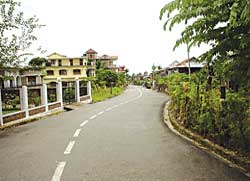 Visiting Dharan in eastern Nepal last week, what was most noticeable were clean, wide and black-topped roads that led to residential areas dotted with lavishly-built houses of ex-British Army soldiers and their families. Locals said most of the roads had been constructed within the last three years-with a part of the money contributed by enlightened residents who have insisted on keeping the level of maintenance high. Indeed, spending the whole day driving around the greater Dharan area to see places of historical interests was a sheer pleasure, worthy enough to be captured for a car commercial.
Visiting Dharan in eastern Nepal last week, what was most noticeable were clean, wide and black-topped roads that led to residential areas dotted with lavishly-built houses of ex-British Army soldiers and their families. Locals said most of the roads had been constructed within the last three years-with a part of the money contributed by enlightened residents who have insisted on keeping the level of maintenance high. Indeed, spending the whole day driving around the greater Dharan area to see places of historical interests was a sheer pleasure, worthy enough to be captured for a car commercial. But the good times seldom last. I had to return to Kathmandu to attend meetings at my head office in Sanepa, where the road, at least in the last three years, has deteriorated to the point that only all-terrain vehicles can ply on them. Parts of it, in fact, have been completely washed away, with nary a maintenance crew in sight since last monsoon.
This discomfort is all the more odd for this reason: on both sides of the road stand either a row of multi-million-rupee private houses with cemented driveways and iron gates or the Nepal offices of various foreign aid agencies. With many wealthy Nepali and enlightened foreign residents around, you would think that they would have demanded better road conditions. Surprisingly, that does not appear to be the case. Though I use the Sanepa road as an example, its conditions mirror those that exist in many areas of Kathmandu. So, what is Dharan's secret? What does it have that Sanepa doesn't?
For answers, it helps to look at three public institutions and see how they do business with one another for the public good. One is the Sewerage Corporation, which also issues tap water. Municipalities make up the second group, while the Road Department is the third party. Their dysfunctional relationships-made all the worse by an apathetic civil society that is weak in its demand for better public services-is the cause for bad roads.
Historically, Kathmandu's drainage system along the residential areas was designed to collect storm water. In time, larger pipes were haphazardly added to this system to collect sewage as well. But as the number of houses increased with permits issued by municipalities to generate easy revenue, that system came under a tremendous strain.
And one result has been that during rainy season, water collected in drainage pipes floods streets and, over time, washes away parts of it. As of today, neither the Sewerage Corporation nor the municipalities have bothered to set up a maintenance division. Frustrated by this, the Road Department sees little incentive to spend money on routine maintenance.
Dharan seems to have found a way out of this sort of a spiralling mess. Led by citizens who demand better public services, Dharan has learnt not only the fine art of how to mobilise local resources to partially pay for an effective delivery of public services. It has also learnt how to achieve better co-ordination among those who design the drainage, make the road and black-top the streets so that citizens can take pride in their streets. Can Kathmandu not learn from Dharan?



